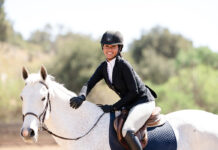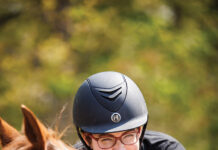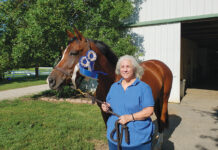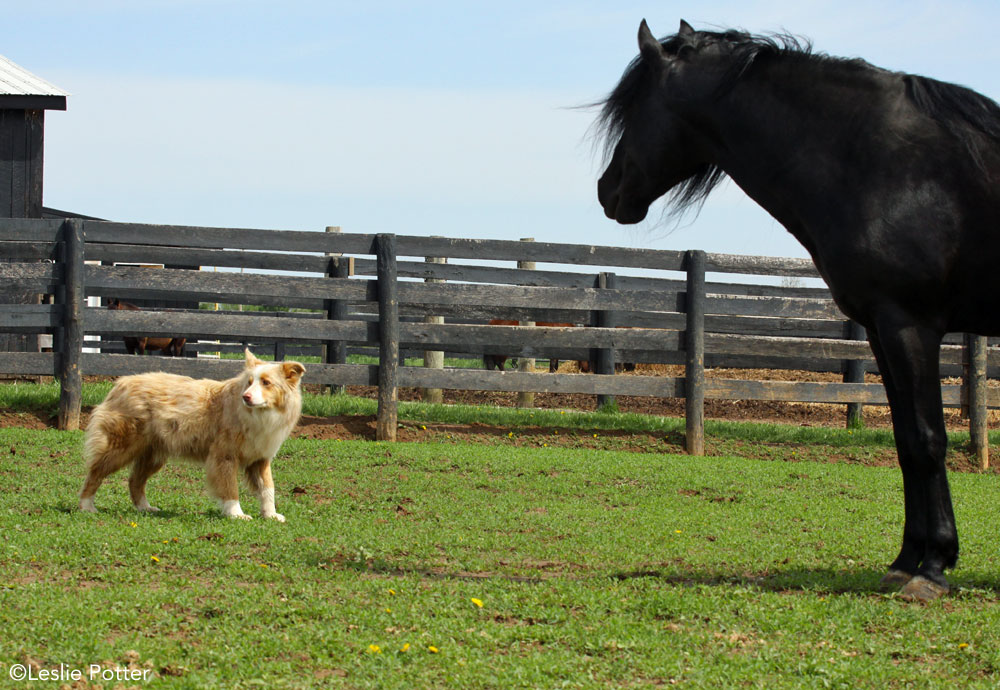
But it’s a relationship that doesn’t always work—you might have a reactive dog or a horse that’s terrified by an animal much smaller than him. Here are some things to consider before introducing your dog into your barn lifestyle.
Basic Manners
Think about handling things with your dog the same way you do with your horse. You wouldn’t take a horse that’s not even green-broke to a show and expect to bring home a blue ribbon, would you? The same goes for dogs: without basic training practices, your dog won’t know how to behave when he is introduced to the wonderful world of barn smells, noises and animals.
“Before introducing your dog to a new environment, it’s helpful to train a few basic behaviors,” says Mandy Eakins, a horse lover and dog trainer who runs Manners Matter Dog Training and Daycare in Nicholasville, Ky.
Eakins shares a few things you should work on at home in order to create a solid foundation with your dog anywhere, not just at the barn.
- A strong sit behavior.
- Eye contact with the owner on cue.
- Leash manners: this includes bathroom behaviors on leash, sitting to greet a stranger, and loose-leash walking.
- Crate manners: this makes hotel stays, trailer time and stall time safe, enjoyable, and less stressful for dog and human.
- Having a good recall: If your dog starts to chase after something or goes off somewhere, you want to be able to call his name and have an efficient response. “The dog should respond happily to his name by turning and looking at the owner,” says Eakins.
Leashing the Beast
“Good leash manners are also important because it’s safest to bring the dog into the area on leash,” Eakins continues. “A well-trained focus and attention cue is also helpful to be able to pull the dog’s attention away from horses and onto the owner.”
And while we’re on the topic of being on leash, she reminds dog owners that if there’s a sign stating “All Dogs Must be on a Leash,” you should abide by that rule.
“There are very few occasions I can advocate for a dog being off leash in a public area,” says Eakins. “Not only is having a dog off-leash a safety concern for the dog, but for those around him.
Golf carts, cars, children, litter on the ground, other dogs, people, and horses are all safety concerns for off-leash dogs. By having your dog on a leash, you eliminate the possibly of your dog getting too far away and putting himself in harm’s way. The best advice for having a dog stay by your side is to have him on a leash. There are options for leashes that attach to the body that give you hands-free options for keeping your dog tethered.”
Retractable leashes should be avoided at the barn. “Even with the leash ‘locked’ in, a dog can pull hard enough to break that lock and chase a horse,” says Erin Dean, trainer and owner of Frontier K9 Training in Central Indiana. “The cord can get wrapped around legs and cause burns or even cuts into the skin. My suggestion would be to stick to using a 6-foot leather lead at all times.”
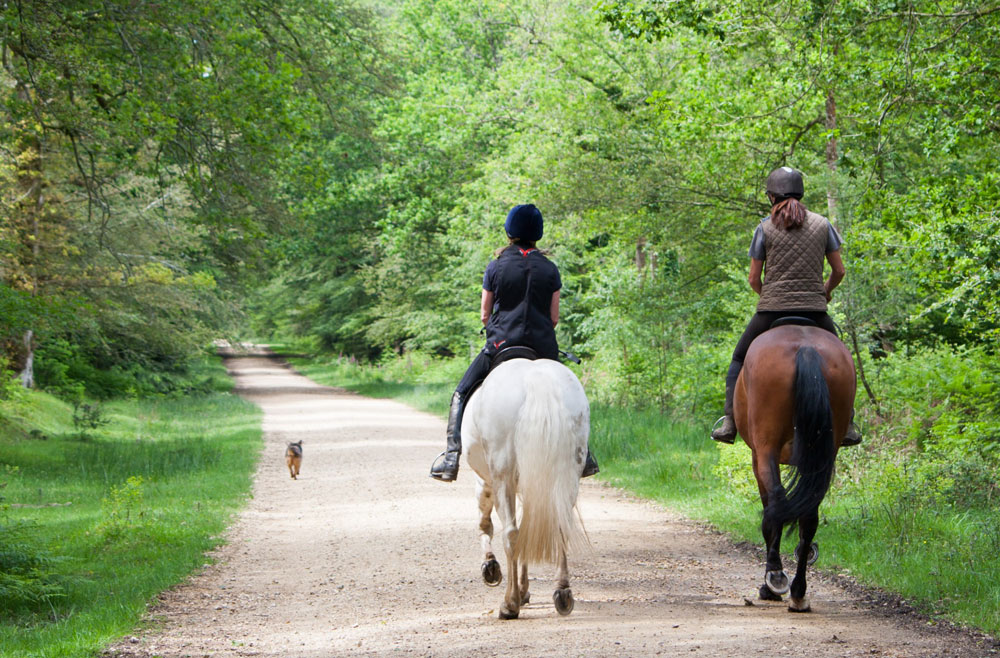
Making Introductions
There is no real timeline for how long it will take to get your dog used to being around horses. For some, it might take one day to know what he can and can’t do. For others, it might take weeks. In some cases, there are dogs that can never be trusted around horses.
Take your time introducing your dog to your horse and the barn area. Be aware of the time of day you bring Fido to the farm. You don’t want to overstimulate him by bringing him out while the horses are running around the pasture because they were just turned out, as that might trigger your dog’s instinct to chase prey.
Keeping your dog on a leash will allow you to have control over how close he can get to the horses. If you have to do something that involves taking your attention away from Fido, place him in a crate where he can watch or in a stall.
“When introducing a dog to horses, it’s important to be proactive in management versus reactive to behavior,” says Eakins. “Setting up the introduction to minimize reaction is important. The key is to create distance between the dog and the horses to allow the dog to slowly acclimate. Using lots of rewards such as treats, praise and a happy voice to create a positive association with the new environment is an important part of introductions.”
You might consider starting the introduction in the barn with the horses tucked safely in their stalls and your dog beside you on leash. Both horses and dogs are curious creatures. Sniffing is all right; just watch your dog’s behavior—are his hackles starting to stand up? Is he starting to growl? Is his tail tucked between his hind legs, or is it wagging side to side? What about your horse? Are his ears pinned or are they pricked forward?
Don’t let your dog get to your horse’s legs or feet where he could nip at them or the horse could strike out and potentially hurt the dog. Keeping distance and being vigilant in your observation is key.
Eakins recommends keeping the initial meetings between dog and horse short and sweet. Allow the dog to sniff the horse, then call him away and reward with a treat and praise, then allow another short meeting between the two. Repeat a few more times.
However, don’t push the meetings—if your horse or dog isn’t feeling the connection right away, pushing it won’t make it better. Take your time in order to develop a positive relationship.
Know the Limits
As a horse and dog lover, you dream of the days you can ride your horse along the trail with your trusty canine sidekick trotting beside you. But the reality is sometimes the two won’t mix.
For example, I have two dogs with different reactions to horses. Dally, my Corgi, is generally very vigilant of the distance between the horse and herself, and tries to maintain that distance. She’ll sit in the middle of the area where I’m riding and watch until I tell her, “OK,” then she’ll run alongside quietly. Because she is a herding dog, her instincts kick into high gear when I turn our horses out in the morning, so she’s locked up in a stall at that time.
Then there’s LaMesa. She is a very reactive Swedish Vallhund who doesn’t know what limits are, no matter the level of training (both of my dogs compete in agility events). The sight of horses causes her to start barking and she wants to nip at their heels. She’s only allowed at the barn if the horses aren’t nearby or they’re in their stalls, and she remains locked in a stall while I ride.
Meanwhile, my sister’s Belgian Malinois listens very well (he’s a retired police K-9). He definitely knows his limits, so he can be around horses any time and isn’t very reactive.
If you keep your horse at a boarding barn, be sure to check with the barn owner to see what the policies are for dogs. And speak with your fellow boarders—just because your horse is fine with dogs, someone else’s might not be. It’s important to respect these concerns so that everyone can continue enjoying the barn, whether human, equine or canine.
About the Expert
Mandy Eakins, KPA, CTP, is a professional dog trainer and dog sport competitor based in Nicholasville, Ky. She has been training dogs for the last 18 years and opened Manners Matter Dog Training and Day Care (www.mannersmatterky.com), serving clients in the central Kentucky area.
Mandy has trained and certified dogs in search and rescue, as well as titled multiple dogs in conformation, agility, competitive obedience and field work. With a background as a veterinary technician and working with several rescue groups, she sees the importance of basic manners and training on dogs to ensure a happy relationship between dog and owner.
This article about barn dogs originally appeared in the July 2018 issue of Horse Illustrated magazine. Click here to subscribe!

